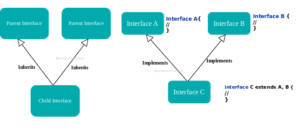As we know, whenever a Java program executes, a thread is created automatically which is coined as Main thread. The main thread is responsible for the creation and termination of other threads from beginning to the end of a program.
So, Java provides two approaches to create a thread.
1) By extending Thread Class
2) By Implementing Runnable Interface
Why Two Ways to create a Thread in Java ?
The reason for this is that Java doesn’t allow the concept of multiple Inheritance. That means, when one uses Thread class in the creation of threads, there would be no way to extend any other class.
To overcome this problem Runnable interface is used where a child class can inherit a class and also able to use thread functionality.
These are the following ways to create a thread in Java:
With the help of Thread Class

A thread class allows us to manage and control any thread using its methods such as getName(),isAlive(),join()and more.
It extends object class and also implements Runnable Interface. A runnable interface that is implemented by Thread class consists of only a single method called run() method where the behavior or task of a thread is defined.
Creating a thread by extending Thread Class
Steps:
- A class should extend the Thread Class
- Need to override the run() method, where all tasks of a thread would be defined
- Create the object of that class, which would act as a thread
- call start() method, for example, thread.start()
- start() invokes run() automatically
class MyFirstThread extends Thread{
@Override
public void run()
{
int i;
for(i=0;i<3;i++)
{
System.out.println("I am First Thread");
}
}
}
class MySecondThread extends Thread{
@Override
public void run()
{
int i;
for(i=0;i<3;i++)
{
System.out.println("I am Second Thread");
}
}
}
public class Threads1 {
public static void main(String[] args) {
MyFirstThread Thread1 = new MyFirstThread();
MySecondThread Thread2 = new MySecondThread();
Thread1.start();
Thread2.start();
}
}
Output:

With the help of Runnable interface
The runnable interface can’t call the run method directly. In order to move a thread to the Runnable state, start() method is used which invokes the run method whose definition is provided in Thread class. So, implementing only the Runnable interface wouldn’t work. Therefore, we need to create an object of a class and pass its reference as an argument to Thread class constructor explicitly.
Creating a thread by Implementing Runnable Interface
Steps:
- A class should implement Runnable interface
- Need to override the run() method, where all tasks of a thread would be defined
- Create the object of that class, suppose ‘obj’
- Create another object but, of Thread class explicitly and pass the reference of the previously created object to the constructor. For example, ‘Thread thread1 = new Thread(obj);’
- call start() method, for example, thread.start()
- start() invokes run() automatically
class A implements Runnable
{
@Override
public void run()
{
int i;
for(i=0;i<5;i++)
{
System.out.println("I am child thread");
}
}
}
public class ImplementRunnable {
public static void main(String[] args) {
A obj = new A();
Thread thread1 = new Thread(obj, "child thread");
thread1.start();
}
}Output:
run:
I am child thread
I am child thread
I am child thread
I am child thread
I am child thread



